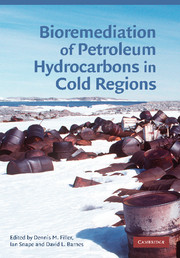Book contents
- Frontmatter
- Contents
- List of contributors
- Preface
- Glossary
- 1 Contamination, regulation, and remediation: an introduction to bioremediation of petroleum hydrocarbons in cold regions
- 2 Freezing and frozen soils
- 3 Movement of petroleum through freezing and frozen soils
- 4 Hydrocarbon-degrading bacteria in contaminated cold soils
- 5 Temperature effects on biodegradation of petroleum contaminants in cold soils
- 6 Analytical methods for petroleum in cold region soils
- 7 Treatability studies: microcosms, mesocosms, and field trials
- 8 Nutrient requirements for bioremediation
- 9 Landfarming
- 10 Thermally enhanced bioremediation and integrated systems
- 11 Emerging technologies
- References
- Index
9 - Landfarming
Published online by Cambridge University Press: 22 August 2009
- Frontmatter
- Contents
- List of contributors
- Preface
- Glossary
- 1 Contamination, regulation, and remediation: an introduction to bioremediation of petroleum hydrocarbons in cold regions
- 2 Freezing and frozen soils
- 3 Movement of petroleum through freezing and frozen soils
- 4 Hydrocarbon-degrading bacteria in contaminated cold soils
- 5 Temperature effects on biodegradation of petroleum contaminants in cold soils
- 6 Analytical methods for petroleum in cold region soils
- 7 Treatability studies: microcosms, mesocosms, and field trials
- 8 Nutrient requirements for bioremediation
- 9 Landfarming
- 10 Thermally enhanced bioremediation and integrated systems
- 11 Emerging technologies
- References
- Index
Summary
Introduction
Landfarming has been described as “a simple technique in which contaminated soil is excavated and spread over a prepared bed and periodically tilled until pollutants are degraded” (Vidali 2001) but, in practice, it can be either an ex situ or in situ technique. Landfarming generally uses a combination of volatilization and biodegradation to reduce hydrocarbon concentrations. For biodegradation to be effective, stimulating aerobic soil microorganisms is essential; this is commonly accomplished by adding nutrients and mixing the soil to increase aeration. Aerating the soil in this way also increases the loss of hydrocarbon contaminants to the atmosphere via volatilization. Volatilization of diesel and lighter hydrocarbons greatly assists the remediation process but it is less effective for heavier molecular weight hydrocarbons such as crude oil.
For in situ landfarming it is possible to treat only relatively shallow layers of soil where reasonable oxygenation can be maintained. In ex situ landfarming, excavated contaminated soil is spread as a thin layer in a treatment bed that is often lined with an impermeable layer to control leaching and runoff. Ex situ landfarming can be as simple as soil spread in a cleared area or it can be a major construction with contouring or drainage systems or both for removal of excess water. Plumbing can also be used for the application of water, either alone or in combination with nutrients or other amendments, to the landfarm surface.
- Type
- Chapter
- Information
- Bioremediation of Petroleum Hydrocarbons in Cold Regions , pp. 170 - 189Publisher: Cambridge University PressPrint publication year: 2008
- 5
- Cited by



